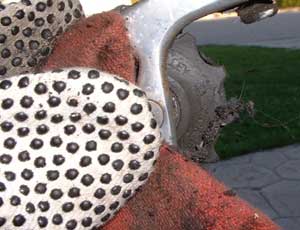BICYCLE REPAIR |
|
| Equipment: Round up the following:
|
|
Keep in mind that if you use a new chain with a worn cassette, you may experience “skipping” while pedaling, which could cause a crash. Skipping is dangerous because under hard pedaling pressure, the chain rides up, off the teeth on the rear cog it's on and jumps forward, which can surprise you with a loud noise and slipping sensation at the pedals. Skipping means you should replace the cassette along with the bad chain. If your new chain does not skip, your cassette is fine to use. |
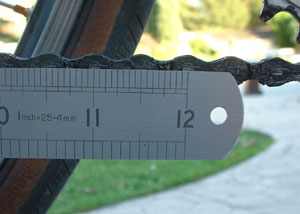 |
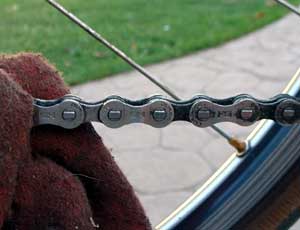 |
 Wipe the chain clean. The easiest way to clean a chain is to put
on some disposable gloves
and wipe the links with a rag dampened in your favorite chain lubricant
(mine is ProGold ProLink
Chain Lube). As long as the chain isn’t really grimy, you’ll
be able to wipe off the greasy mess (photo) with a few minutes
of scrubbing. Remember to clean both sides and the top and bottom of the
chain. Note that using lube for cleaning instead of solvent ensures that
your chain remains lubed.
Wipe the chain clean. The easiest way to clean a chain is to put
on some disposable gloves
and wipe the links with a rag dampened in your favorite chain lubricant
(mine is ProGold ProLink
Chain Lube). As long as the chain isn’t really grimy, you’ll
be able to wipe off the greasy mess (photo) with a few minutes
of scrubbing. Remember to clean both sides and the top and bottom of the
chain. Note that using lube for cleaning instead of solvent ensures that
your chain remains lubed. |
Note that pro mechanics use diesel fuel as a solvent (you can also
just use your favorite lube) because it contains oil and won't completely
strip the chain of lube. You don't want to strip the chain because it's
difficult to get lube back between the small parts that comprise the
chain and if you don't, it can develop squeaks
that won't go away. |
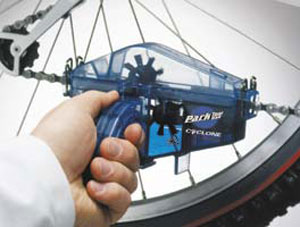 |
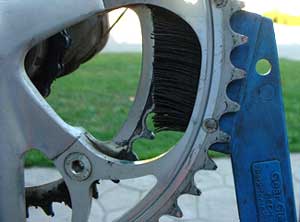 |
If your crankset is a big mess, another way to clean it that takes more time but is really satisfying when you see the results, is to remove the chainring bolts and remove the chainrings and scrub all the parts with solvent, rags and brushes, then reassemble it. Just be sure to pay close attention to how it goes together BEFORE you take it apart (take a photo with your cellphone). The chainrings and bolts only go on one way. |
|
Now, dampen a rag with solvent or lube and slip the wet edge of the rag between two cogs. Use a shoe-shine motion with the rag (photo) to clean the cogs (this will rotate the cassette ensuring that you clean the cogs entirely). Then repeat with each pair of cogs until they’re clean. Also get under the top cog to clean its backside and wipe off the lockring (the inner ring on the outside). Reinstall the wheel. There's actually a pretty cool product available for cleaning between
the cassette cogs called Finish
Line Gear Floss. |
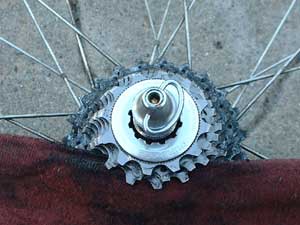 |
|
|
 Check the derailleurs. Inspect the pulleys on the rear derailleur
and wipe off any built-up sludge (photo). If you find any hardened
grime deposits, chip them off with your small screwdriver. Then run a
rag through the front derailleur cage to clean it thoroughly. As a last
step, apply fresh lube to your chain and derailleurs.
Check the derailleurs. Inspect the pulleys on the rear derailleur
and wipe off any built-up sludge (photo). If you find any hardened
grime deposits, chip them off with your small screwdriver. Then run a
rag through the front derailleur cage to clean it thoroughly. As a last
step, apply fresh lube to your chain and derailleurs. |
 to the WRENCH page
|
|
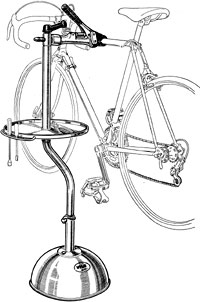
 Check the chain for wear. If you’ve logged mega miles, the
chain may be worn out. If so, rather than cleaning, you should replace
it. To check, shift the chain onto the large chainring. Now, rest a
ruler alongside the lower run of chain and see if you can measure exactly
12 inches between two pins 24 links apart (photo). If so, your
drivetrain is okay. If the second pin exceeds the 12-inch mark by 1/8
inch or more, your chain is worn out and should be replaced.
Check the chain for wear. If you’ve logged mega miles, the
chain may be worn out. If so, rather than cleaning, you should replace
it. To check, shift the chain onto the large chainring. Now, rest a
ruler alongside the lower run of chain and see if you can measure exactly
12 inches between two pins 24 links apart (photo). If so, your
drivetrain is okay. If the second pin exceeds the 12-inch mark by 1/8
inch or more, your chain is worn out and should be replaced.  Scrub the chain clean. A chain caked with sludge requires more
drastic measures. You can put some solvent in a bucket, place this under
the chain and brush the links to dissolve the grime. By dipping often,
brushing and, when the chain is clean, wiping off the excess solvent,
you’ll get things spic and span. An easier way is to use a chain-cleaning
tool such as the one sold by
Scrub the chain clean. A chain caked with sludge requires more
drastic measures. You can put some solvent in a bucket, place this under
the chain and brush the links to dissolve the grime. By dipping often,
brushing and, when the chain is clean, wiping off the excess solvent,
you’ll get things spic and span. An easier way is to use a chain-cleaning
tool such as the one sold by  Clean the crankset. Lift the chain off the small ring and rest
it on the frame. Clean the large chainring and the inside of the small
chainring with a rag. Knock off any grimy deposits on the surfaces
between the rings with a small screwdriver and then use a
Clean the crankset. Lift the chain off the small ring and rest
it on the frame. Clean the large chainring and the inside of the small
chainring with a rag. Knock off any grimy deposits on the surfaces
between the rings with a small screwdriver and then use a  Clean the cassette. Remove the rear wheel and rest it on your
workbench with the cassette facing up. Rest the wheel so the tire
touches the wall to keep the wheel from turning as you clean the cassette.
Clean the cassette. Remove the rear wheel and rest it on your
workbench with the cassette facing up. Rest the wheel so the tire
touches the wall to keep the wheel from turning as you clean the cassette.
